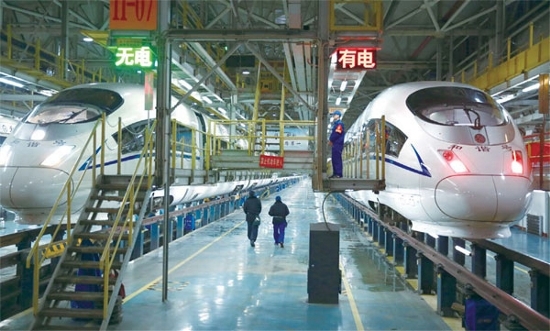
Chinese companies gear up to export bullet trains, rail technology and equipment, and subway cars
CRRC Corporation Limited, the country's largest train-maker, plans to build bullet trains and provide other services in developed markets, including the United States and the United Kingdom, over the next five years to compete with established rivals in Europe, Japan and Canada.
Many opportunities come from the surging demand in these countries for improved railway infrastructure, passenger services and regional connectivity, as well as their desire to create jobs and new commercial areas.
CRRC has set a target of 30 percent growth by 2020 in its research and development ability from current levels. This is especially applicable to its three bullet train subsidiaries: CRRC Changchun Co Ltd, CRRC Tangshan Co Ltd and CRRC Qingdao Sifang Co Ltd.
Yu Weiping, vice-president of CRRC, says the company is also developing "smart trains", which will use advanced technologies that enable automatic controls of speed and interior conditions, and fault detection.
The goal is to grab a bigger share of the global market from foreign competitors, he says, adding that the company is in talks with more than 30 countries about high-speed rail projects, including the US, Russia, Brazil, Thailand, Turkey, Saudi Arabia and Iran.
CRRC and its partner, China Railway Corp, the railway service provider, were selected by the Indonesian government last year to build the nation's first bullet train link. The two companies will construct a $5.5 billion line stretching 150 kilometers from the capital, Jakarta, to Bandung.
It will be China's first overseas high-speed train project and involves design and construction work, financing solutions, and operational and maintenance services.
With more than 186,963 employees and 46 subsidiaries covering industries such as signal system design and train equipment production, CRRC has already built manufacturing facilities and maintenance centers in the US, Malaysia, Turkey and Brazil.
Yu says the company is keen to contribute to a new high-speed rail culture in the US.
"With high-speed trains traveling at speeds of more than 300 km/h, it will help the US to change its ground commuting systems, which have long been dominated by automobiles," he says.
Even though China is a latecomer compared with its German and French rivals, Yu says the country's rail equipment companies have thrived thanks to cost advantages, reasonable delivery times and flexible financing models.
The Chinese government announced in September that a 370-km, high-speed railway project between Las Vegas and Los Angeles will be built by a joint venture involving China Railway Construction Corp, China Railway Corp and XpressWest Enterprises, a US passenger rail service provider.
The construction work between Nevada and California is expected to start in September, and the estimated investment is $12.7 billion.
Wang Yongzhi, chief information officer at CRRC, says the Belt and Road Initiative will also help China export more high-speed rail technologies to a number of lucrative markets during the 13th Five-Year Plan, the nation's development blueprint for 2016 to 2020.
The trade and infrastructure network, proposed by China in 2013, envisions a Silk Road Economic Belt and a 21st Century Maritime Silk Road, covering about 4.4 billion people in more than 60 countries and regions in Asia, Europe and Africa.
CRRC is also preparing to export bullet trains for a high-speed rail project in Russia that would connect Moscow to Kazan. The length of the line is expected to be about 770 km and will run through seven Russian regions with a total population of more than 25 million.
"As most countries along the initiative (routes) - especially in Central Asia, Southeast Asia, the Middle East and Eastern Europe - are planning to build high-speed rail lines or upgrade their existing railway systems, they are willing to acquire technological support from China to assist in the daily operations, maintenance, staff training and other services," Wang says.